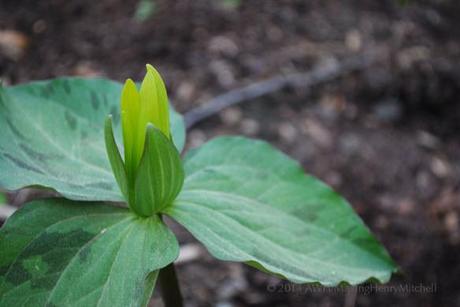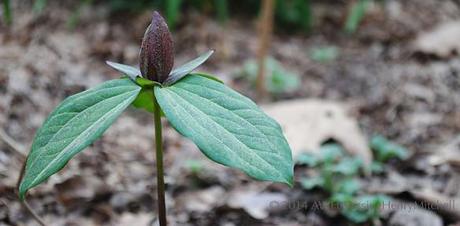My favorite time of the gardening year is when my trilliums come into bloom.

Trillium luteum
These plants, native (in the case of Trillium luteum) to North Carolina, grow in deciduous forests. Slow-growing and typically reproduced by tissue culture, they command hefty prices at nurseries and garden centers, in the range of $15-20 for a quart pot containing one plant. Please don’t use this as an excuse to harvest them from their native habitat; that’s strictly taboo.
I have been waiting patiently for perhaps eight years for these plants to multiply. This year, I think the oldest of my three plants may send up a second bloom. Growing trilliums is a bit like watching children mature, I suppose; the gardener must exercise a great deal of patience as the subject slowly and rather invisibly matures, showing exciting glimpses in brief bursts of what lovely and graceful specimens they will become.
Well, my patience is not where it ought to be. You can imagine my excitement, then, when I read in Nancy Goodwin’s delightful book, Montrose: Life in a Garden, about how she increased her stand of Trillium catesbaei by pricking the rhizomes with a pin to stimulate new growth. She describes a ninefold increase in her plants in one year using this technique.
I contacted Nancy to ask about the process and she assured me it was extremely simple. Uncover the rhizome (easiest to do now, when the flower is visible), and prick it with a pin beneath the growing point, found at the end of the rhizome. The injury stimulates the plant to produce additional tubers, she writes. Perhaps while the plant photosynthesizes, it pumps more energy into additional tuber/rhizome (I will grasp this one day) formation, yielding a greater increase than would occur if, say, the gardener tried this technique during the plant’s dormancy.
Yesterday I gave it a try. I dug gently down with my fingers, not wanting to risk severing the rhizome with a vigorous plunge of a trowel (perhaps an irrational thought, given what I was about to do). I found the growing point, or what I think is the growing point, and, not having a pin to hand, gave it a timid poke with the tip of a pair of scissors. I made an incision only detectible by the droplet of white fluid that emerged from the rhizome. I filled the hole back up and firmed it well. I tried the technique on two of the three plants, so if I’ve erred in my execution, next year I can be assured of having at least one plant surviving (the one that’s sending up two flowers this year).
Feeling a bit bold, I tried it on the single specimen I have of Trillium sessile as well.

Trillium sessile, dusted with pollen
Next year, we’ll see what emerges. You may want to give this technique a try in your own gardens. If you do, please let me know your results.

